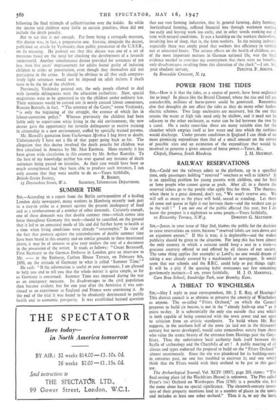A THREAT TO WINCHELSEA
SIR,—May I reply to your correspondent, Mr. J. E. Ray, of Hastings? This district council is as anxious to preserve the amenity of Winchelsea as anyone. The so-called "Friars Orchard," on which the Council proposes to build six houses, is not in the " already built-up area " as it exists to-day. It is substantially the only site outside that area which is both capable of being connected with the town sewer and not open to criticism from an artistic standpoint. To build where Mr. Ray suggests, in the southern half of the town (as laid out in the thirteenth century but never developed), would raise tremendous outcry from those who value the scenic beauty of the entrance from Hastings past the Grey- friars. Thus the unfortunate local authority finds itself between the Scylla of archaeology and the Charybdis of art ! A public meeting of all classes and types endorsed the proposal to build on the "Friars Orchard" almost unanimously. Since the site was plundered for its building-stone in centuries past, no one has troubled to excavate it; and one would think that the Friars would wish their orchard to be put to this good use.
The Archeological Journal, Vol. XCIV (1937), page 203, states: "The final resting place (of the Blackfriars House) is unknown. The Plot called Fryer's (sic) Orchard on Wardropers Plan (1763) is a possible site, but the name alone has no special significance. The sixteenth-century inven- tory of their property mentions land in a number of places in the town, and includes at least one other orchard." Thus it is, to say the least,
doubtful whether the Black Friars ever had their house here. though they certainly had an orchard.—Yours faithfully,
W. C. HUME-SPEY
(Chairman, Housing Programme Committee. Battle R.D.C.) Heather Cottage, Netherfield Road, Battle, Sussex.



































 Previous page
Previous page